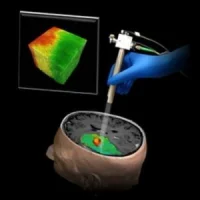A new, highly sensitive ultrasound-guided technique can noninvasively identify metastatic cells in lymph nodes, providing a rapid tool for detecting cancer’s spread at its earliest stages, which is critical for timely treatment. The technology, developed at the University of Texas at Austin and the University of Texas MD Anderson Cancer Center, is reported in the October issue of Cancer Research.
The new technique — so far tested in mice — uses an imaging approach known as ultrasound-guided photoacoustics combined with nanosensors designed to target and identify very small numbers of cancer cells, known as micrometastases, in lymph nodes.
“Our method has a great potential to provide dramatic improvement in the clinical staging, prognosis, and therapeutic planning for cancer patients with metastatic disease without the need for invasive surgical biopsy,” says Dr. Stanislav Emelianov, Professor of Imaging Physics at UT MD Anderson Cancer Center and one of the study's senior authors.
More than 90 percent of cancer deaths can be attributed to metastases either directly or indirectly. In current clinical practice, an invasive surgical procedure called sentinel lymph node (SLN) biopsy is used to identify the regional spread of tumour. However, this procedure results in adverse effects including pain, swelling, numbness and risk of infection in hundreds of thousands of cancer patients per year.
While other noninvasive imaging modalities (eg, positron emission tomography or PET) have been tested in animals and patients, these methods lack the specificity and sensitivity to replace invasive lymph node biopsy. In contrast, the UT-developed noninvasive technology may have better sensitivity, accuracy and specificity than surgical biopsy.
The improvement in sensitivity and accuracy comes from the smart imaging probe that interacts with the metastatic cells. The UT team built a molecularly activated plasmonic nanosensor (MAPS) for this task. The MAPS components include a gold nanoparticle, which is the part of the nanosensor that is seen by the imaging system. The MAPS nanosensor also contains an antibody to the epidermal growth factor receptor (EGFR). This antibody was chosen because EGFR has been shown to be abnormally highly expressed on the surface of many cancer cells including oral cavity, lung, and cervix.
To detect the gold nanoparticles bound to metastatic cells in the lymph nodes, the researchers developed an ultrasound-guided spectroscopic photoacoustic (sPA) imaging system. The technology provides the high contrast and sensitivity of optical imaging with the ability of ultrasound to provide clear resolution even in tissues deep inside the body.
The UT researchers tested the system in a mouse model of oral cancer. The mice were injected with the EGFR-targeted MAPS and were subsequently imaged using sPA. The results showed that the MAPS bound specifically to the metastatic cells in the lymph nodes near the oral cavity tumour and were clearly visible with the sPA imaging system.
Overall, tumour-bearing mice injected with the EGFR-targeted MAPS showed a sensitivity of 100 percent and a specificity of 87 percent for detection of lymph node micrometastases as small as 50 micrometres, which corresponds to about 30 metastatic cells. The detection of such a small number of cells in the lymph node offers a system that has the ability to identify metastasis very early in the process, which would allow early treatment.
“This combination greatly improves sensitivity and specificity of detection of cancerous cells in lymph nodes as compared to any other imaging modality in use today,” says another senior author Konstantin Sokolov, PhD, of the University of Texas MD Anderson Cancer Center.
The researchers anticipate that this system can be translated into use in the clinic following some alterations in the system to make it functional and safe in humans.
Source and image credit: National Institute of Biomedical Imaging and Bioengineering
The new technique — so far tested in mice — uses an imaging approach known as ultrasound-guided photoacoustics combined with nanosensors designed to target and identify very small numbers of cancer cells, known as micrometastases, in lymph nodes.
“Our method has a great potential to provide dramatic improvement in the clinical staging, prognosis, and therapeutic planning for cancer patients with metastatic disease without the need for invasive surgical biopsy,” says Dr. Stanislav Emelianov, Professor of Imaging Physics at UT MD Anderson Cancer Center and one of the study's senior authors.
More than 90 percent of cancer deaths can be attributed to metastases either directly or indirectly. In current clinical practice, an invasive surgical procedure called sentinel lymph node (SLN) biopsy is used to identify the regional spread of tumour. However, this procedure results in adverse effects including pain, swelling, numbness and risk of infection in hundreds of thousands of cancer patients per year.
While other noninvasive imaging modalities (eg, positron emission tomography or PET) have been tested in animals and patients, these methods lack the specificity and sensitivity to replace invasive lymph node biopsy. In contrast, the UT-developed noninvasive technology may have better sensitivity, accuracy and specificity than surgical biopsy.
The improvement in sensitivity and accuracy comes from the smart imaging probe that interacts with the metastatic cells. The UT team built a molecularly activated plasmonic nanosensor (MAPS) for this task. The MAPS components include a gold nanoparticle, which is the part of the nanosensor that is seen by the imaging system. The MAPS nanosensor also contains an antibody to the epidermal growth factor receptor (EGFR). This antibody was chosen because EGFR has been shown to be abnormally highly expressed on the surface of many cancer cells including oral cavity, lung, and cervix.
To detect the gold nanoparticles bound to metastatic cells in the lymph nodes, the researchers developed an ultrasound-guided spectroscopic photoacoustic (sPA) imaging system. The technology provides the high contrast and sensitivity of optical imaging with the ability of ultrasound to provide clear resolution even in tissues deep inside the body.
The UT researchers tested the system in a mouse model of oral cancer. The mice were injected with the EGFR-targeted MAPS and were subsequently imaged using sPA. The results showed that the MAPS bound specifically to the metastatic cells in the lymph nodes near the oral cavity tumour and were clearly visible with the sPA imaging system.
Overall, tumour-bearing mice injected with the EGFR-targeted MAPS showed a sensitivity of 100 percent and a specificity of 87 percent for detection of lymph node micrometastases as small as 50 micrometres, which corresponds to about 30 metastatic cells. The detection of such a small number of cells in the lymph node offers a system that has the ability to identify metastasis very early in the process, which would allow early treatment.
“This combination greatly improves sensitivity and specificity of detection of cancerous cells in lymph nodes as compared to any other imaging modality in use today,” says another senior author Konstantin Sokolov, PhD, of the University of Texas MD Anderson Cancer Center.
The researchers anticipate that this system can be translated into use in the clinic following some alterations in the system to make it functional and safe in humans.
Source and image credit: National Institute of Biomedical Imaging and Bioengineering
Latest Articles
healthmanagement, cancer, metastasis, lymph node, imaging
A new, highly sensitive ultrasound-guided technique can noninvasively identify metastatic cells in lymph nodes, providing a rapid tool for detecting cancer’s spread at its earliest stages.










